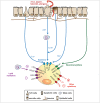ILC2s-Trailblazers in the Host Response Against Intestinal Helminths
- PMID: 31019505
- PMCID: PMC6458269
- DOI: 10.3389/fimmu.2019.00623
ILC2s-Trailblazers in the Host Response Against Intestinal Helminths
Abstract
Group 2 innate lymphoid cells (ILC2s) were first discovered in experimental studies of intestinal helminth infection-and much of our current knowledge of ILC2 activation and function is based on the use of these models. It is perhaps not surprising therefore that these cells have also been found to play a key role in mediating protection against these large multicellular parasites. ILC2s have been intensively studied over the last decade, and are known to respond quickly and robustly to the presence of helminths-both by increasing in number and producing type 2 cytokines. These mediators function to activate and repair epithelial barriers, to recruit other innate cells such as eosinophils, and to help activate T helper 2 cells. More recent investigations have focused on the mechanisms by which the host senses helminth parasites to activate ILC2s. Such studies have identified novel stromal cell types as being involved in this process-including intestinal tuft cells and enteric neurons, which respond to the presence of helminths and activate ILC2s by producing IL-25 and Neuromedin, respectively. In the current review, we will outline the latest insights into ILC2 activation and discuss the requirement for-or redundancy of-ILC2s in providing protective immunity against intestinal helminth parasites.
Keywords: ILC2; activation; helminth; neuron; regulation; tuft cell; type 2 immunity.
Figures

Similar articles
-
The ChAT-acetylcholine pathway promotes group 2 innate lymphoid cell responses and anti-helminth immunity.Sci Immunol. 2021 Mar 5;6(57):eabe3218. doi: 10.1126/sciimmunol.abe3218. Sci Immunol. 2021. PMID: 33674322 Free PMC article.
-
What Can Parasites Tell Us About the Pathogenesis and Treatment of Asthma and Allergic Diseases.Front Immunol. 2020 Sep 11;11:2106. doi: 10.3389/fimmu.2020.02106. eCollection 2020. Front Immunol. 2020. PMID: 33013887 Free PMC article. Review.
-
Group 2 ILCs: A way of enhancing immune protection against human helminths?Parasite Immunol. 2018 Feb;40(2):e12450. doi: 10.1111/pim.12450. Epub 2017 Jul 12. Parasite Immunol. 2018. PMID: 28626924 Free PMC article. Review.
-
Granulocytes: effector cells or immunomodulators in the immune response to helminth infection?Parasite Immunol. 2010 Jan;32(1):1-19. doi: 10.1111/j.1365-3024.2009.01147.x. Parasite Immunol. 2010. PMID: 20042003 Review.
-
Systemic impact of intestinal helminth infections.Mucosal Immunol. 2014 Jul;7(4):753-62. doi: 10.1038/mi.2014.23. Epub 2014 Apr 16. Mucosal Immunol. 2014. PMID: 24736234 Review.
Cited by
-
Chemokines and Innate Lymphoid Cells in Skin Inflammation.Cells. 2021 Nov 8;10(11):3074. doi: 10.3390/cells10113074. Cells. 2021. PMID: 34831296 Free PMC article. Review.
-
Dengue virus co-opts innate type 2 pathways to escape early control of viral replication.Commun Biol. 2022 Jul 22;5(1):735. doi: 10.1038/s42003-022-03682-5. Commun Biol. 2022. PMID: 35869167 Free PMC article.
-
Btn2a2 Regulates ILC2-T Cell Cross Talk in Type 2 Immune Responses.Front Immunol. 2022 Jan 25;13:757436. doi: 10.3389/fimmu.2022.757436. eCollection 2022. Front Immunol. 2022. PMID: 35145516 Free PMC article.
-
Communication is key: Innate immune cells regulate host protection to helminths.Front Immunol. 2022 Sep 26;13:995432. doi: 10.3389/fimmu.2022.995432. eCollection 2022. Front Immunol. 2022. PMID: 36225918 Free PMC article. Review.
-
NKp46+ natural killer cells develop an activated/memory-like phenotype and contribute to innate immunity against experimental filarial infection.Front Immunol. 2022 Sep 27;13:969340. doi: 10.3389/fimmu.2022.969340. eCollection 2022. Front Immunol. 2022. PMID: 36238293 Free PMC article.
References
Publication types
MeSH terms
Substances
Supplementary concepts
LinkOut - more resources
Full Text Sources

